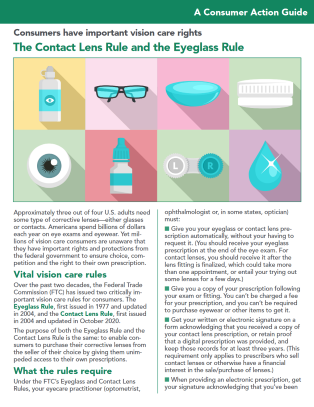The Contact Lens Rule and the Eyeglass Rule
Consumers have important vision care rights
The approximately 75% of U.S. adults who need some type of corrective lenses spend billions of dollars each year on eye exams and eyewear, yet few understand their rights under the federal Contact Lens Rule and Eyeglass Rule. This publication explains those rights, provides links to additional information, and tells you where you can report violations of the rules.

Publication Series
- This publication is not currently associated with any training series.
Download File
PDF files may contain outdated links.
The Contact Lens Rule and the Eyeglass Rule
File Name: contact_lens_rule_2020_EN_v1.1.pdf
File Size: 0.26MB
Languages Available
Table of Contents
Approximately three out of four U.S. adults need some type of corrective lenses—either glasses or contacts. Americans spend billions of dollars each year on eye exams and eyewear. Yet millions of vision care consumers are unaware that they have important rights and protections from the federal government to ensure choice, competition and the right to their own prescription.
Vital vision care rules
Over the past two decades, the Federal Trade Commission (FTC) has issued two critically important vision care rules for consumers: the Eyeglass Rule, first issued in 1977 and updated in 2004, and the Contact Lens Rule, first issued in 2004 and updated in October 2020.
The purpose of both the Eyeglass Rule and the Contact Lens Rule is the same: to enable consumers to purchase their corrective lenses from the seller of their choice by giving them unimpeded access to their own prescriptions.
What the rules require
Under the FTC’s Eyeglass and Contact Lens Rules, your eyecare practitioner (optometrist, ophthalmologist or, in some states, optician) must:
- Give you your eyeglass or contact lens prescription automatically, without your having to request it. (You should receive your eyeglass prescription at the end of the eye exam. For contact lenses, you should receive it after the lens fitting is finalized, which could take more than one appointment, or entail your trying out some lenses for a few days.)
- Give you a copy of your prescription following your exam or fitting. You can’t be charged a fee for your prescription, and you can’t be required to purchase eyewear or other items to get it.
- Get your written or electronic signature on a form acknowledging that you received a copy of your contact lens prescription, or retain proof that a digital prescription was provided, and keep those records for at least three years. (This requirement only applies to prescribers who sell contact lenses or otherwise have a financial interest in the sale/purchase of lenses.)
- When providing an electronic prescription, get your signature acknowledging that you’ve been given a digital copy of your prescription in a format that you can use, access, download and print.
- Respond to a request for an additional copy of the prescription, by you or your contact lens or eyeglass seller, within 40 business hours.
- Verify a prescription within eight business hours. (Online sellers should tell you how to send or upload a copy of your prescription. If you don’t submit your actual prescription, you’ll have to provide precise information about it, such as recommended lens brand, power, base curve, or diameter, etc. You’ll also need to supply your prescriber’s contact information so that the seller can verify the prescription. If your prescriber doesn’t respond to the seller’s request within eight business hours, the seller can sell you those lenses after the eight-hour wait time expires.)
- Provide a prescription that is valid for at least one year (or longer, if state law imposes a minimum of more than one year), unless the prescriber has a medical reason for setting a shorter expiration date.
The Contact Lens Rule and Eyeglass Rule take precedence over more lenient state laws.
Learn more about the rules
Understanding Your Prescription Rights for Glasses and Contact Lenses
Contact Lens Rule updates: What they mean for you
FAQs: Complying with the contact lens rule
Exercising your rights
Under the updated Contact Lens Rule (effective Oct. 16, 2020), the FTC requires prescribers to get and keep confirmation that they provided a copy of the contact lens prescription to their patients. (The requirement to automatically provide a copy of the prescription was often ignored in the past.)
If your prescriber does not comply with the requirements of the Rule—for example, by not giving you your prescription automatically, or by not supplying a copy or prescription verification within the required time frame—you can remind them of their obligations under the Contact Lens Rule or Eyeglass Rule.
You also can report the issue to the FTC online or by phone. To file a complaint online, click “Report Now” and choose “Health” in the list of complaint topics. While the FTC doesn’t resolve individual issues, your report helps the agency investigate rule violations and could lead to enforcement action.
You also can file a complaint with your state’s consumer protection agency if state law has been violated as well.
About this guide
Consumer Action has been working to protect critical consumer vision care rights. Visit Consumer Action’s Vision Action Center webpage to learn about your corrective lens prescription rights, how online contact lens prescription renewal services work, view short videos and more.
Consumer Action is a member of the Coalition for Contact Lens Consumer Choice, a bipartisan coalition of consumer and taxpayer groups, companies and community groups fighting for vision care rights.
Published / Reviewed Date
Published: November 09, 2020
Download File
The Contact Lens Rule and the Eyeglass Rule
File Name: contact_lens_rule_2020_EN_v1.1.pdf
File Size: 0.26MB
Sponsors
Filed Under
Consumer Rights ♦ Medical/Healthcare ♦
Copyright
© 2020 –2024 Consumer Action. Rights Reserved.



